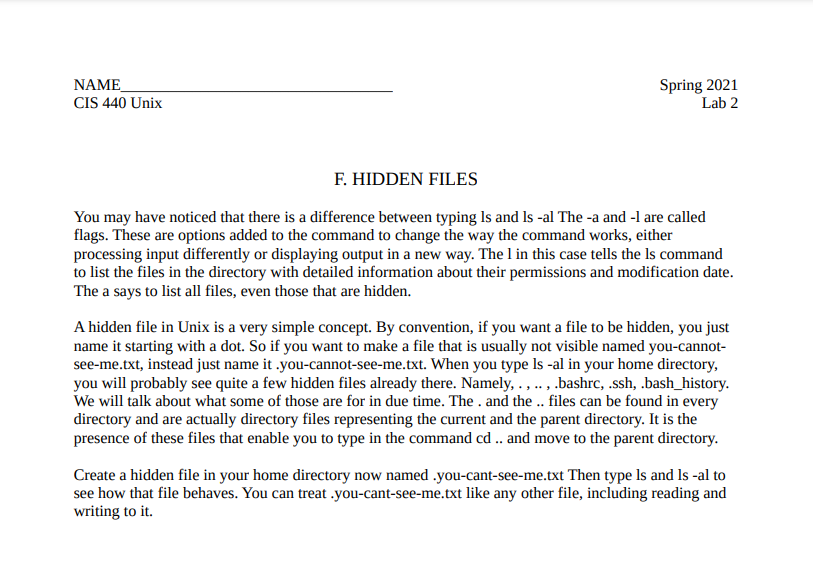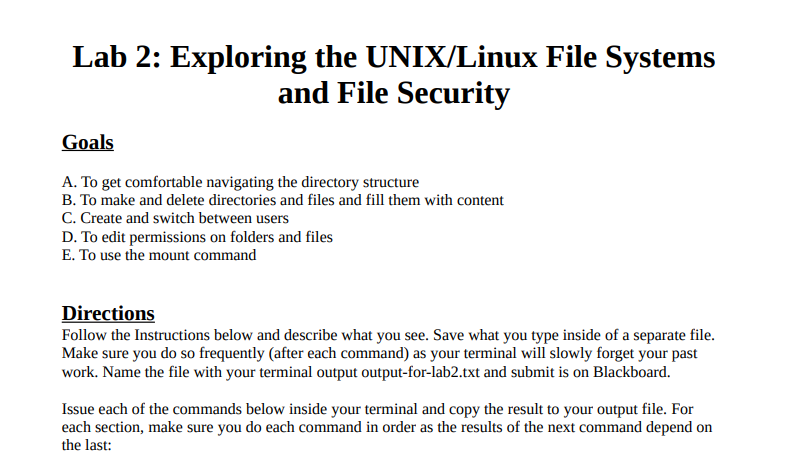please copy and paste the output So i can copy and paste it to my own txt file. ty will give thumbs up if done correctly :)


NAME CIS 440 Unix Spring 2021 Lab 2 F. HIDDEN FILES You may have noticed that there is a difference between typing Is and ls -al The -a and -1 are called flags. These are options added to the command to change the way the command works, either processing input differently or displaying output in a new way. The l in this case tells the ls command to list the files in the directory with detailed information about their permissions and modification date. The a says to list all files, even those that are hidden. A hidden file in Unix is a very simple concept. By convention, if you want a file to be hidden, you just name it starting with a dot. So if you want to make a file that is usually not visible named you-cannot- see-me.txt, instead just name it.you-cannot-see-me.txt. When you type ls -al in your home directory, you will probably see quite a few hidden files already there. Namely, ...., .bashrc, .ssh, bash_history. We will talk about what some of those are for in due time. The . and the .. files can be found in every directory and are actually directory files representing the current and the parent directory. It is the presence of these files that enable you to type in the command cd .. and move to the parent directory. Create a hidden file in your home directory now named.you-cant-see-me.txt Then type ls and ls -al to see how that file behaves. You can treat .you-cant-see-me.txt like any other file, including reading and writing to it. Lab 2: Exploring the UNIX/Linux File Systems and File Security Goals A. To get comfortable navigating the directory structure B. To make and delete directories and files and fill them with content C. Create and switch between users D. To edit permissions on folders and files E. To use the mount command Directions Follow the Instructions below and describe what you see. Save what you type inside of a separate file. Make sure you do so frequently (after each command) as your terminal will slowly forget your past work. Name the file with your terminal output output-for-lab2.txt and submit is on Blackboard. Issue each of the commands below inside your terminal and copy the result to your output file. For each section, make sure you do each command in order as the results of the next command depend on the last: NAME CIS 440 Unix Spring 2021 Lab 2 F. HIDDEN FILES You may have noticed that there is a difference between typing Is and ls -al The -a and -1 are called flags. These are options added to the command to change the way the command works, either processing input differently or displaying output in a new way. The l in this case tells the ls command to list the files in the directory with detailed information about their permissions and modification date. The a says to list all files, even those that are hidden. A hidden file in Unix is a very simple concept. By convention, if you want a file to be hidden, you just name it starting with a dot. So if you want to make a file that is usually not visible named you-cannot- see-me.txt, instead just name it.you-cannot-see-me.txt. When you type ls -al in your home directory, you will probably see quite a few hidden files already there. Namely, ...., .bashrc, .ssh, bash_history. We will talk about what some of those are for in due time. The . and the .. files can be found in every directory and are actually directory files representing the current and the parent directory. It is the presence of these files that enable you to type in the command cd .. and move to the parent directory. Create a hidden file in your home directory now named.you-cant-see-me.txt Then type ls and ls -al to see how that file behaves. You can treat .you-cant-see-me.txt like any other file, including reading and writing to it. Lab 2: Exploring the UNIX/Linux File Systems and File Security Goals A. To get comfortable navigating the directory structure B. To make and delete directories and files and fill them with content C. Create and switch between users D. To edit permissions on folders and files E. To use the mount command Directions Follow the Instructions below and describe what you see. Save what you type inside of a separate file. Make sure you do so frequently (after each command) as your terminal will slowly forget your past work. Name the file with your terminal output output-for-lab2.txt and submit is on Blackboard. Issue each of the commands below inside your terminal and copy the result to your output file. For each section, make sure you do each command in order as the results of the next command depend on the last








